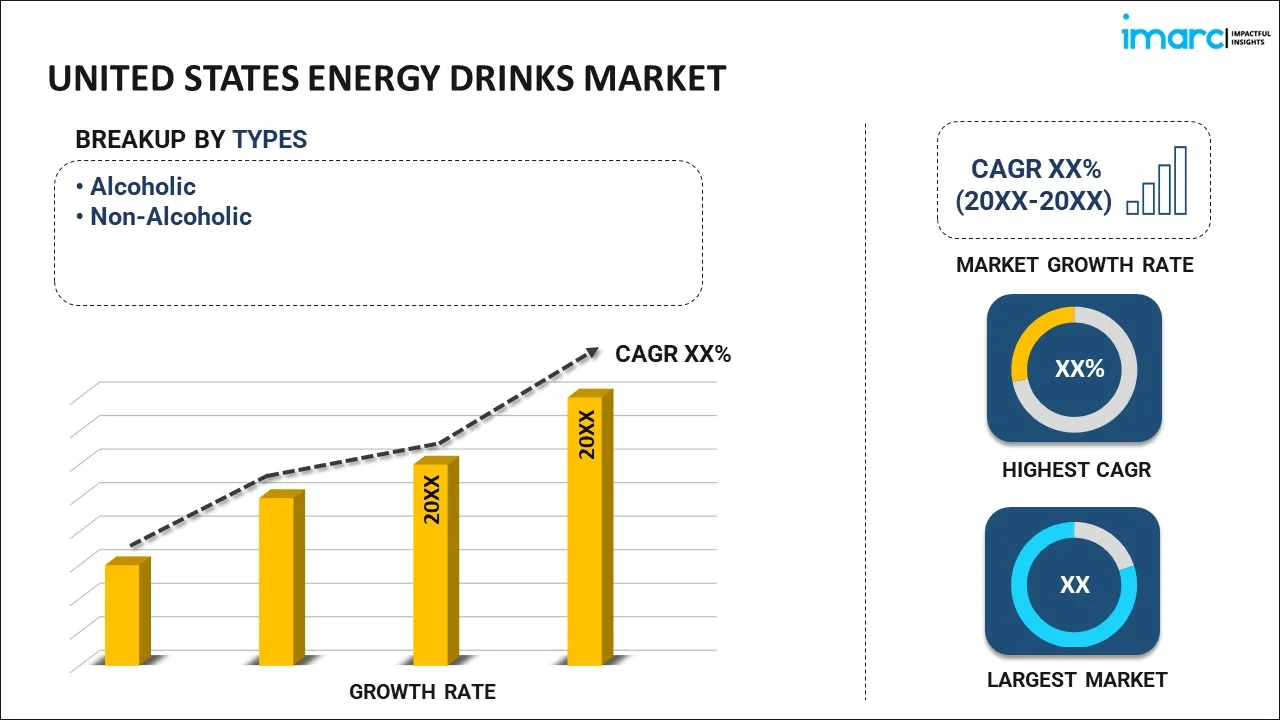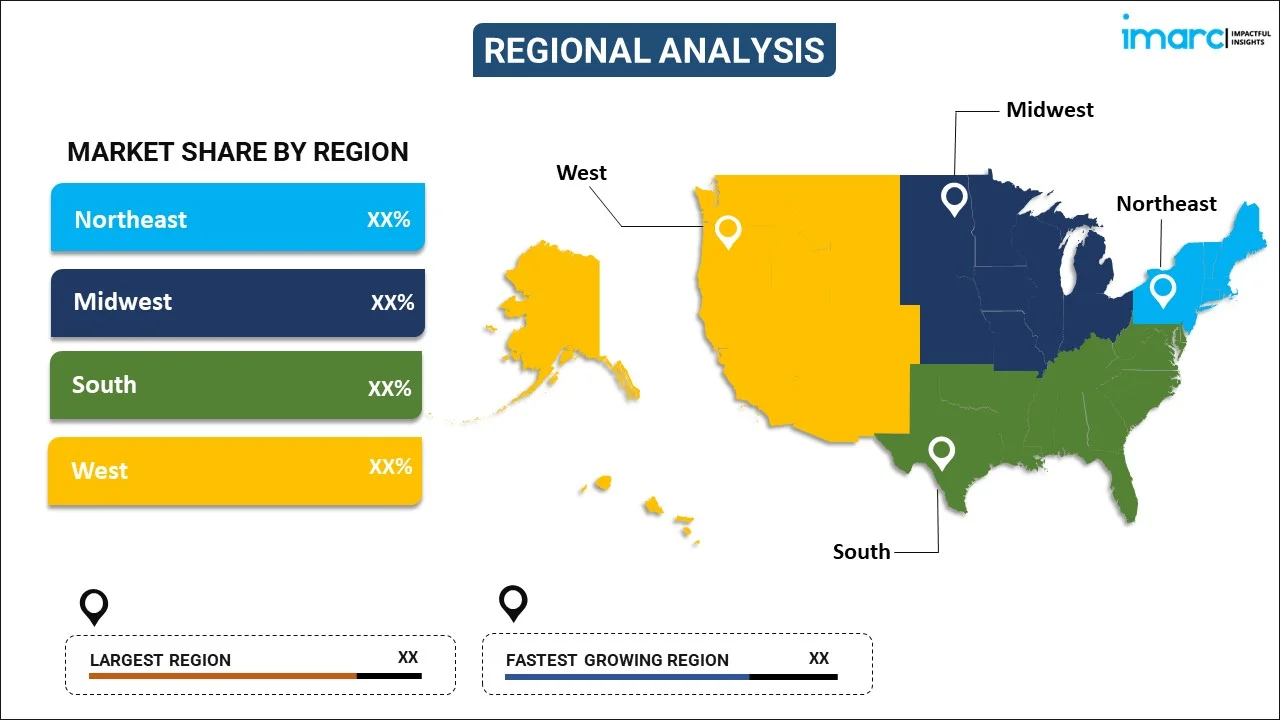
United States Energy Drinks Market Report by Type (Alcoholic, Non-Alcoholic), End User (Kids, Adults, Teenagers), Distribution Channel (Supermarkets and Hypermarkets, Specialty Stores, Convenience Stores, Online Stores, and Others), and Region 2025-2033
United States Energy Drinks Market Size:
The United States energy drinks market size reached USD 12.0 Billion in 2024. Looking forward, IMARC Group expects the market to reach USD 37.1 Billion by 2033, exhibiting a growth rate (CAGR) of 6.52% during 2025-2033. The market is experiencing steady growth due to increased consumer awareness and preference for functional beverages, expansion of distribution channels, rapid urbanization and busy lifestyles of the consumers, the increasing influence of digital marketing and social media, and a paradigm shift towards natural and organic ingredients.
|
Report Attribute
|
Key Statistics
|
|---|---|
|
Base Year
|
2024 |
|
Forecast Years
|
2025-2033 |
|
Historical Years
|
2019-2024
|
| Market Size in 2024 | USD 12.0 Billion |
| Market Forecast in 2033 | USD 37.1 Billion |
| Market Growth Rate (2025-2033) | 6.52% |
United States Energy Drinks Market Analysis:
- Major Market Drivers: Major market drivers of the United States market include increased consumer awareness, preference for functional beverages, rising demand among the youth population, and expanding distribution channels. As health consciousness grows, consumers are seeking drinks that offer more than just hydration, driving them towards energy drinks that promise improved physical and mental performance. The youth demographic, particularly millennials and Generation Z, are turning to these beverages for quick energy boosts during busy days. Additionally, companies are expanding their reach through diverse distribution networks, including supermarkets, convenience stores, and online platforms. These factors are crucial in creating a favorable United States energy drinks market outlook.
- Key Market Trends: Key market trends in the United States market include innovation and product diversification, the shift towards natural and organic ingredients, and the influence of digital marketing. Companies are continually introducing unique flavors, limited edition products, and specialty drinks to cater to specific consumer needs. There is also a noticeable trend towards using natural ingredients, appealing to health-conscious consumers. Digital marketing strategies, such as influencer partnerships and interactive social media campaigns, are playing a significant role in engaging consumers and driving sales. These trends are shaping the United States energy drinks market overview.
- Geographical Trends: Geographical trends in the United States market reveal a significant concentration of demand in urban areas. As urbanization increases, so does the fast-paced lifestyle that necessitates quick energy solutions. Energy drinks are particularly popular in metropolitan regions where busy professionals, students, and athletes seek convenient energy drinks. Additionally, regional preferences for flavors and ingredients influence product offerings, with some areas showing a higher demand for natural and organic products. As per the United States energy drinks market overview, the urban-centric demand and regional preferences highlight the diverse nature of the market.
- Competitive Landscape: The competitive landscape of the market is dominated by prominent giants that maintain their market leadership through continuous innovation, product diversification, and strategic marketing initiatives. Additionally, these key players are leveraging digital marketing strategies and influencer partnerships to enhance brand visibility and engage consumers effectively. The fierce competition among these brands is highlighting the dynamic nature of the market, thereby creating lucrative United States energy drinks market recent opportunities.
- Challenges and Opportunities: The market faces several challenges and opportunities. One significant challenge is the increasing scrutiny regarding the health impacts of energy drinks, which can impact the health of some consumers. However, this challenge also presents an opportunity for companies to innovate with healthier formulations, such as low-sugar and natural ingredient options. The growing trend towards sustainability also offers opportunities for brands to adopt eco-friendly packaging, appealing to environmentally conscious consumers. Additionally, the expanding reach of digital marketing is providing new avenues for consumer engagement and market growth.
United States Energy Drinks Market Trends:
Rising health and wellness trends
The growing focus on health and wellness trends among the masses is driving the market in the United States. Individuals are becoming active and thus demanding functional beverages that can provide them with an instant boost of energy. This trend is prevalent among millennials and Gen Z who are more health-conscious and seek products that align with their fitness goals. In addition to this, consumers are shifting towards buying natural and organic ingredients-based energy drinks hence creating a positive market outlook. In addition, brands that underscore the wellness outcomes of their merchandise such as better focus, improved athletic performance, or lessened tiredness have recorded escalated sales volumes hence contributing to increased customer loyalty, which, in turn, is supporting the United States energy drinks market growth.
Expansion of distribution channels and strategic marketing
The expansion of distribution channels and strategic marketing initiatives are also crucial in elevating the US market. Manufacturers of energy drinks are now leveraging multiple distribution networks such as supermarkets, convenience stores, e-commerce platforms, and vending machines for wider consumer reach. In addition, strategic integration with sports events, music festivals, and other marquee experiences further enhances brand visibility and consumer engagement, thus supporting the market. Innovative marketing campaigns often include endorsements from famous athletes and celebrities, attracting more consumers. These efforts are directly contributing to increased United States energy drinks market revenue.
Shift towards natural and organic ingredients
The increasing demand for natural and organic components is supporting the market in the United States. With increased awareness among consumers regarding the harmful effects of artificial additives, individuals are switching towards energy drinks manufactured using natural and organic ingredients. This trend is prompting energy drink manufacturers to reformulate their products to include more natural ingredients, such as organic caffeine, natural sweeteners, and plant-based extracts. These products are often marketed as better-line or organic coffee alternatives for consumers focused on natural products. The penetration of natural and organic ingredients in energy drinks is further supporting the United States energy drinks market demand.
United States Energy Drinks Market Segmentation:
IMARC Group provides an analysis of the key trends in each segment of the market, along with forecasts at the regional and country levels for 2025-2033. Our report has categorized the market based on type, end user, and distribution channel.
Breakup by Type:

- Alcoholic
- Non-Alcoholic
The report has provided a detailed breakup and analysis of the market based on the type. This includes alcoholic and non-alcoholic.
Breakup by End User:
- Kids
- Adults
- Teenagers
A detailed breakup and analysis of the market based on the end user have also been provided in the report. This includes kids, adults, and teenagers.
Breakup by Distribution Channel:
- Supermarkets and Hypermarkets
- Specialty Stores
- Convenience Stores
- Online Stores
- Others
The report has provided a detailed breakup and analysis of the market based on the distribution channel. This includes supermarkets and hypermarkets, specialty stores, convenience stores, online stores, and others.
Breakup by Region:

- Northeast
- Midwest
- South
- West
The report has also provided a comprehensive analysis of all the major markets in the country, which include Northeast, Midwest, South, and West.
Competitive Landscape:
- The market research report has also provided a comprehensive analysis of the competitive landscape in the market. Detailed profiles of all major companies have been provided.
- United States energy drinks companies are employing various strategies to remain competitive and propel sales. Key companies are exploring and innovating with their product lines. Red Bull has introduced new flavors and limited-edition launches to sustain consumer interest in the category. Monster Beverage Corporation is diversifying its product portfolio by launching beverages for different purposes such as performance-enhancing sports drinks and focus-related soft drinks. Major players are focusing on sustainability and are turning to eco-friendly packaging solutions to cater to more environmentally conscious consumers. Additionally, key players are effectively using social media platforms and influencer partnerships to widen their reach. These United States energy drinks market recent developments are crucial for maintaining market share and driving consumer interest in a highly competitive landscape.
United States Energy Drinks Market News:
- On 2nd July 2024, Exponent Energy Inc., a London-based maker of plant-based, sugar-free energy drinks, announced it is shifting production to Black Fly Beverage Co. to increase capacity and meet growing demand in the U.S. and Canada. This strategic move allows Exponent Energy to enhance its production capabilities and better serve its expanding market.
- On 3rd April, 2024, Nutrabolt's C4 Energy became the first-ever official energy drink partner of WWE in the United States, featuring prominent branding across WWE properties and events, including WrestleMania XL. This partnership also launched WWE-inspired flavors like Ruthless Raspberry and Berry Powerbomb, with a new flavor, Nectarine Guava Knockout, available exclusively at Circle K.
United States Energy Drinks Market Report Scope:
| Report Features | Details |
|---|---|
| Base Year of the Analysis | 2024 |
| Historical Period | 2019-2024 |
| Forecast Period | 2025-2033 |
| Units | Billion USD |
| Scope of the Report | Exploration of Historical Trends and Market Outlook, Industry Catalysts and Challenges, Segment-Wise Historical and Future Market Assessment:
|
| Types Covered | Alcoholic, Non-Alcoholic |
| End Users Covered | Kids, Adults, Teenagers |
| Distribution Channels Covered | Supermarkets and Hypermarkets, Specialty Stores, Convenience Stores, Online Stores, Others |
| Regions Covered | Northeast, Midwest, South, West |
| Customization Scope | 10% Free Customization |
| Post-Sale Analyst Support | 10-12 Weeks |
| Delivery Format | PDF and Excel through Email (We can also provide the editable version of the report in PPT/Word format on special request) |
Key Questions Answered in This Report:
- How has the United States energy drinks market performed so far, and how will it perform in the coming years?
- What has been the impact of COVID-19 on the United States energy drinks market?
- What is the breakup of the United States energy drinks market on the basis of type?
- What is the breakup of the United States energy drinks market on the basis of end user?
- What is the breakup of the United States energy drinks market on the basis of distribution channel?
- What are the various stages in the value chain of the United States energy drinks market?
- What are the key driving factors and challenges in the United States energy drinks market?
- What is the structure of the United States energy drinks market, and who are the key players?
- What is the degree of competition in the United States energy drinks market?
Key Benefits for Stakeholders:
- IMARC’s industry report offers a comprehensive quantitative analysis of various market segments, historical and current market trends, market forecasts, and dynamics of the United States energy drinks market from 2019-2033.
- The research report provides the latest information on the market drivers, challenges, and opportunities in the United States energy drinks market.
- Porter's five forces analysis assists stakeholders in assessing the impact of new entrants, competitive rivalry, supplier power, buyer power, and the threat of substitution. It helps stakeholders to analyze the level of competition within the United States energy drinks industry and its attractiveness.
- The competitive landscape allows stakeholders to understand their competitive environment and provides an insight into the current positions of key players in the market.
Need more help?
- Speak to our experienced analysts for insights on the current market scenarios.
- Include additional segments and countries to customize the report as per your requirement.
- Gain an unparalleled competitive advantage in your domain by understanding how to utilize the report and positively impacting your operations and revenue.
- For further assistance, please connect with our analysts.
 Inquire Before Buying
Inquire Before Buying
 Speak to an Analyst
Speak to an Analyst
 Request Brochure
Request Brochure
 Request Customization
Request Customization




.webp)




.webp)












